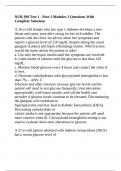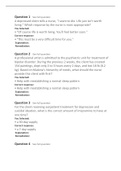Exam (elaborations)
NR 390 Chamberlain College Of Nursing -NUR 390 Test 1 - Part 2 Modules 3 Questions With Complete Solutions
- Course
- NR 390
- Institution
- Chamberlain College Of Nursing
NR 390 Chamberlain College Of Nursing -NUR 390 Test 1 - Part 2 Modules 3 Questions With Complete Solutions
[Show more]








